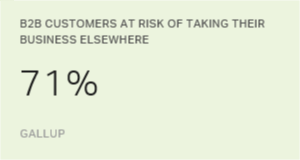Story Highlights
- Culture is notoriously difficult to change
- Changing a company's culture could help drive organic growth
- Elements of organizational identity: purpose, brand and culture
This article is the first in a two-part series.
Countless companies say they have a customer-centric culture. But Gallup finds that few actually do.
For example, a company will claim that it's all about the customer experience, but will have a performance management system built on sales incentives. Or a company might talk a good game about customer service, but will not give its employees any service values on which to act.
Though problematic, the disconnect makes sense. Culture is notoriously difficult to change, and in the business-to-business (B2B) domain, it's even more challenging. Not all companies believe they even have a culture, and those that do are likely to label their culture as product- or sales-focused.
But does culture matter for B2B companies? The answer is an unequivocal yes. B2B entities absolutely must understand how their customers feel about them and use that knowledge to shape their culture and the way they do business. This awareness is particularly needed as B2B companies pursue organic growth -- that is, as they try to get more business from existing customers. Culture could play a vital role in that effort. But B2B companies won't achieve organic growth with only 29% of their customers engaged, 60% indifferent and 11% actively disengaged.
Taking a Holistic Approach to Cultural Change
Business leaders often regard cultural change as somewhat of an enigma. Plenty are interested in it, but not many have figured out how to make it happen. Gallup has spent decades studying organizational culture and discovered that companies often cannot transform their culture because their approaches are too narrow. They look at culture in a vacuum and don't factor in the other elements that matter. In Gallup's experience, companies that want to create or sustain a strong culture can only do so by focusing on the larger dynamic: their organizational identity.
Organizational identity is made up of three interrelated elements: purpose, brand and culture.
- Purpose: Why does our organization exist, and why are we here?
- Brand: How are we known to the world?
- Culture: How do we live, and how do we accomplish work around here?
Purpose, brand and culture provide an overarching structure for companies to focus their work and resources as well as drive business strategy and performance. Each of these elements is important and meaningful in its own right, but aligning them gives companies the fuel to ignite change and lays the foundation for sustainable high performance.
Alignment has incredible power. Companies gain momentum when their employees move in the same direction toward the same goal. That momentum allows them to deliver a seamless, differentiated customer experience. Everyone -- from current and prospective employees and customers to shareholders, industry influencers and members of the media -- thinks and talks about the company in the same way.
Defining the Three Elements
Purpose: Everything follows purpose. An organization's purpose, or mission, tells the world why it's here, what it stands for and -- just as importantly -- what it does not stand for. As the guiding principle for actions, behaviors and decisions, purpose rarely changes; rather, it evolves.
In B2B organizations, it's common to have a purpose along the lines of "make money" or "provide a return to shareholders." But purpose should be about more than profit margins; it should get to the heart of the enterprise. A meaningful and well-articulated purpose can attract and retain employees. Workers who are passionate about their company contribute more and stay longer. They build better customer relationships and are the most effective recruiters and advocates for the company.
For purpose to matter, organizations have to move beyond words on a wall or a few paragraphs in their employee handbooks. Leaders and managers must ensure that every employee understands the company's purpose and can connect it with his or her individual work. They have to speak about purpose regularly and live it through their actions. Purpose should inspire commitment on behalf of each employee.
Brand: With a clearly defined and well-supported purpose, an organization can build a differentiated brand that reflects its position in the marketplace. And it can develop and deliver a unique brand promise: the statement of what it offers, what separates it from its rivals and what makes it worthy of customers' consideration.
A brand is more than a tagline, billboard or television commercial. B2B companies do not have to hire marketing agencies or invest in expensive advertising campaigns to build a brand. They only need to create a strong brand promise and consistently deliver on it. They have to earn their customers' trust and the right to do business with them.
But before companies can build their brand externally, they need to build it internally -- through their employees. If employees don't believe in the products they are creating or the services they are selling, there is no reason to think that customers will. Leaders and managers must have conversations with their employees about the brand and help them connect their work to it.
Culture: Purpose also informs culture, or the road map that articulates for every employee in the organization "how we do things around here." B2B companies have operating manuals for most aspects of their businesses. Culture is also an operating manual that gives employees ground rules and guidelines for living the organization's purpose and delivering on the brand promise.
Culture is instrumental because it either facilitates and supports organizational success or undermines and inhibits it. Companies with a strong, successful culture understand that reinforcing the culture is a constant priority. They recognize those who live the culture, continually emphasize desired behaviors and align their performance management systems with their cultural aspirations.
The next article will discuss how to change an organization's culture and strengthen its identity.



